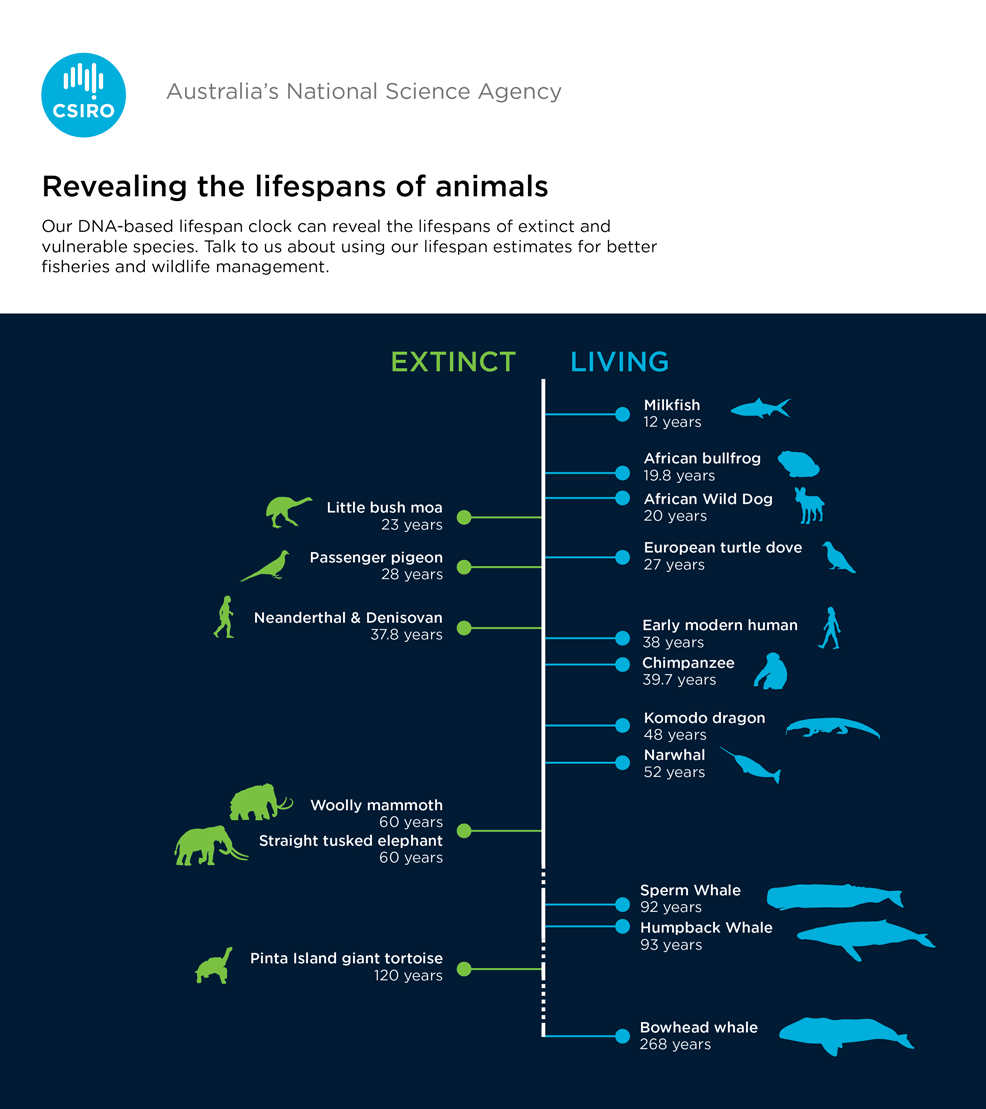
19th December 2019 Genetic 'clock' predicts lifespan in vertebrates Using the human genome, researchers have found the 'natural' lifespan of humans is 38, which matches anthropological estimates of lifespan in early modern humans. This new DNA-based method, applied to other vertebrate species, means their lifespans can readily be estimated.
Scientists have created a new model that uses genetic markers to accurately estimate the lifespans of different vertebrate species. The 'lifespan clock' screens 42 selected genes for CpG sites, short pieces of DNA whose density is correlated with lifespan, to predict how long members of a given vertebrate species may live. The maximum lifespan for a species is difficult to define and can differ greatly between organisms. Previous research has suggested that it is controlled by genes – but so far, no gene variants have been found that account for these differences. To build their model, a team from CSIRO, Australia's national science agency, used reference genomes of 252 vertebrate species with known lifespans to identify 42 genes that may be predictive of lifespan. They found that CpG density in the identified genes was highly predictive of lifespan, including of extinct species. "Our method for estimating maximum natural lifespan is based on DNA. If a species' genome sequence is known, we can estimate its lifespan," explains the senior author of this study, Dr Ben Mayne, a postdoctoral fellow with CSIRO's Environomics Future Science Platform. "Until now, it has been difficult to estimate lifespan for most wild animals – particularly long-living species of marine mammals and fish." Using their technique, his team found the maximum lifespan of the bowhead whale is 268 years, which is 57 years longer than previously thought. That means a bowhead whale born today, in the absence of any human or other external threats, could live until the year 2287. They also discovered that woolly mammoths lived for 60 years, and that the recently extinct Pinta Island giant tortoise from the Galapagos lived for 120 years (based on the genome of "Lonesome George", the last surviving member of his species). Neanderthals and Denisovans were calculated to have a maximum lifespan of 37.8 years, similar to modern humans living around the same time. "Based on DNA, we also estimated a 'natural' lifespan for modern humans of 38 years," says Mayne, writing in The Conversation. "This matches some anthropological estimates for early modern humans. However, humans today may be an exception to this study, as advances in medicine and lifestyle have extended the average lifespan."
"Knowing the lifespan of wild animals is fundamental for wildlife management and conservation," adds Mayne. "For endangered species, lifespan can be used to understand what populations are viable. In industries such as fisheries, lifespan is used in population models to determine catch limits. However, the lifespan of most animals is unknown. Most estimates come from a small number of individuals living in captivity whose ages at death were known. For long-lived species it is difficult to obtain a lifespan, as they may outlive a generation of researchers." "There are many genes linked to lifespan, but differences in the DNA sequences of those genes doesn't seem to explain differences in lifespan between different species," Mayne adds. "Instead, we think that the density of a special type of DNA change, called DNA methylation, determines maximum natural lifespan in vertebrates. DNA methylation does not change a gene's sequence, but helps control whether and when it is switched on. "Using the known lifespans of 252 different vertebrate species, we were able to accurately predict lifespan from the density of DNA methylation occurring within 42 different genes. These genes are likely to be good targets for studying aging, which is of huge biomedical and ecological significance." The research appears this month in the online journal Scientific Reports.
Comments »
If you enjoyed this article, please consider sharing it:
|








